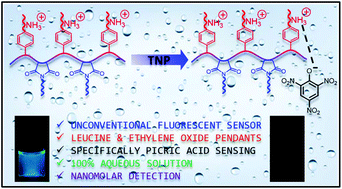A nonconjugated macromolecular luminogen for speedy, selective and sensitive detection of picric acid in water†
Abstract
Development of a speedy, selective, and sensitive detection method for picric acid (PA) in an aqueous medium using a simple, cost-effective, and portable sensory technique is in high demand not only because of PA's explosive nature but also because of its superior water solubility. This study reports a nonconjugated macromolecular luminogen for prompt sensing of PA in 100% aqueous environments. A novel water-soluble unconventional fluorescent alternating copolymer based on a poly(styrene-alt-maleimide) skeleton has been found to be selective for nanomolar detection of PA in pure water over other aromatic compounds, without any interference from other nitroaromatics and metal ions or common anions that may coexist. The polymeric sensor molecule also has the capability to detect PA in the solid state and vapor phase. The fluorimetric sensing mechanism of PA in the present fluorescent probe is attributed to combined ground-state electrostatic complex formation and ground-state electron transfer from picrate anion to the probe molecule, as evidenced by UV–vis and 1H NMR studies, time-resolved fluorescence measurement, cyclic voltammetry, and density functional theory (DFT) calculations.



 Please wait while we load your content...
Please wait while we load your content...